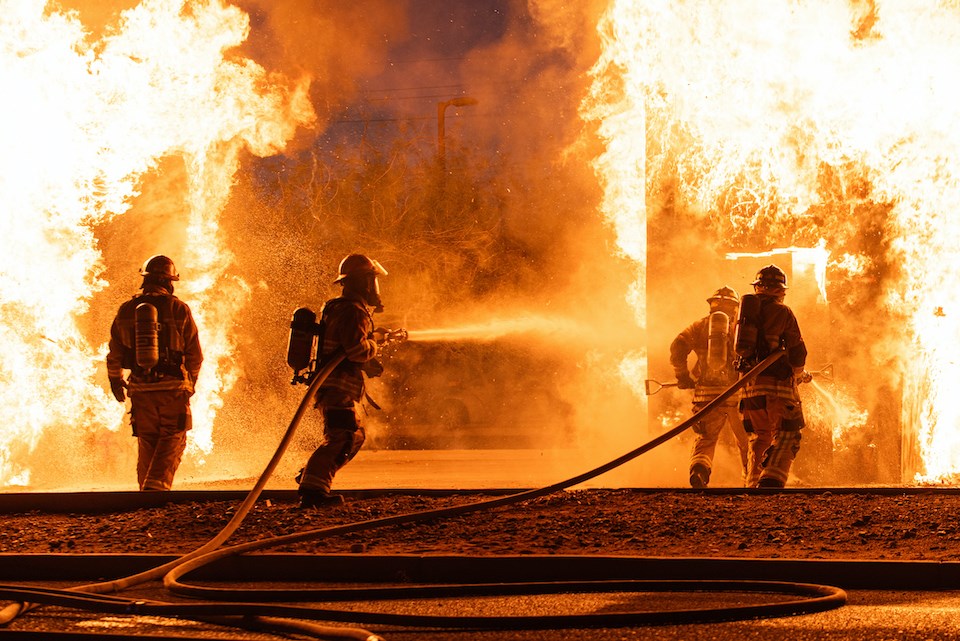Metro Vancouver isn't immune to widespread wildfires like the ones devastating southern California.
The Government of Canada says multiple wildfires broke out in southern California on Jan. 7 and Jan. 8, including the Palisades Fire in the Pacific Palisades neighbourhood of Los Angeles and the Eaton Fire in Altadena, adjacent to Pasadena.
To date, the wildfires have killed at least 27 people and destroyed thousands of homes. Estimated damages are in the billions.
Southern California's warm, dry, and ultra-powerful Santa Ana winds reached speeds over 129 km/h, literally fanning the flames of the wildfires and spreading massive embers.
Lori Daniels is a professor of forest ecology at the University of British Columbia and the faculty's Koerner Chair in Wildfire Coexistence. She researches forest and wildfire dynamics in Western Canada and says the Lower Mainland has the potential for a disastrous conflagration given the right conditions.
"It's already happened in Canada. We have seen fires spread through communities, wildland fires, where the ember or the flames ignited homes and then the fire becomes contagious from home to home," she tells V.I.A.
Wildfires have partially or fully destroyed several towns and cities across the province. While several factors contribute to fires, rising temperatures increase their likelihood dramatically.
Metro Vancouver weather forecast likely to include future 'heat dome' conditions
The BC Coroners Service confirmed 619 deaths from the devastating 2021 heat dome from June 25 to July 1. Western Canada's temperatures soared 20 C above seasonal averages, with Lytton experiencing the highest at 49.6 C on June 29. The following day, the entire town burned to the ground.
A February 2024 report from the Vancouver Coastal Health Authority states that scientific research anticipates Metro Vancouver will experience extreme heat waves like the one in 2021 every five to 10 years by 2040.
Metro Vancouver's climate is notably different than B.C. Interior's but that doesn't make it immune to wildfires, Daniels points out.
Dramatic lightning storms are notably rare in the Lower Mainland and the region receives significantly more rainfall than the Interior.
However, fire ignition sources that affect homes and communities in Metro Vancouver start in the "wildland-urban interface and are almost exclusively in and around neighbourhoods, recreation sites, or transportation corridors" and are most often caused by people.
Daniels says Los Angeles is similar to Vancouver in that most of its fires are human-caused, either directly or indirectly, such as by leaving a candle unattended, a downed power line, an electrical issue, fireworks, or a tossed cigarette. California also has a significantly denser population.
The causes of the Palisades and Eaton fires have not been determined and are under investigation.
Powerful wind can easily spread fire
As Metro Vancouver's population continues growing and heat waves occur, devastating fires are possible, particularly if people don't practice wildfire mitigation tactics in and around their homes.
"Our communities are not prepared for the types of fires that are burning in California and that could potentially burn here as well," Daniels notes.
While the Lower Mainland doesn't experience winds as powerful as the Santa Ana winds, Environment Canada issues wind warnings throughout the year with speeds high enough to spread a fire.
Kelowna declared a state of emergency in August 2021 after powerful winds swept an out-of-control wildfire across Okanagan Lake.
"We could easily get a wind of equal force in the Lower Mainland," she notes. "Winds go from high in the mountains to the ocean. Even sustained wind for a few hours could spread fire from house to house."
Daniels points to how the City of Richmond's fire department was called in to help Vancouver firefighters when they exhausted resources and personnel battling two out-of-control blazes in the Dunbar neighbourhood and East Vancouver.
Vancouver Fire Rescue Services said the Dunbar fire consumed a multi-storey apartment building under construction, while the flaming embers set nine other nearby homes on fire. The crane used to construct the building collapsed onto a home across the street.
Firefighters also put out spot fires in Pacific Spirit Regional Park — 10 blocks away.
Concurrently, a major fire in East Vancouver was ignited in an apartment building a year after a fire displaced 70 residents. The crew battled the blaze through the night and had to "actively manage" hotspots the following morning.
"Could you imagine if that fire had been on a windy day during the 2021 heat dome? That fire would have consumed multiple structures throughout the neighbourhood in Dunbar and perhaps created a conflagration in Pacific Spirit Park," Daniels remarks.
"We are not immune in the Lower Mainland. It's true we live in a coastal temperate rainforest but our climate is summer dry and the fire season is during the summer. Our summers are becoming hotter and drier.
"We've had multiple summers where we are under extreme fire danger in the Lower Mainland, for not just days but weeks on end."
Locals should be 'fire smart' and protect their homes
Daniels encourages locals to be "fire smart" and actively make their homes safer as the climate evolves.
"Let's think also about ways to reconfigure gardens, keeping plants away from the home and thinking about putting in a rock garden up close to it instead. Long grass is also flammable" she says.
Cedar trees are also highly flammable and should be trimmed off the ground. They should be placed away from a home.
When choosing home building materials, a wood frame is sustainable but the exterior materials, such as roofing materials, should be fire-resistant. Non-flammable materials are preferred for siding, such as brick, stone, and metal, Daniels recommends.
"We are naive to suggest that [a major wildfire] could not happen here. We are not immune."
With files from Stefan Labbé and the Canadian Press



